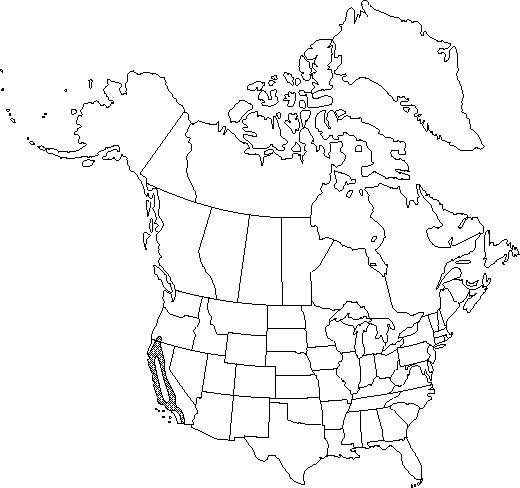Difference between revisions of "Eschscholzia caespitosa"
Trans. Hort. Soc. London, ser. 2, 1: 408. 1835.
Treatment appears in FNA Volume 3.
FNA>Volume Importer |
FNA>Volume Importer |
||
| Line 16: | Line 16: | ||
}}<!-- | }}<!-- | ||
| − | --><span class="statement" id="st- | + | --><span class="statement" id="st-undefined" data-properties=""><b>Plants </b>annual, caulescent, erect, tufted, 5-30 cm, glabrous, sometimes slightly glaucous. <b>Leaves</b> basal and cauline; blade with ultimate lobes short (giving compact appearance), obtuse or acute. <b>Inflorescences</b> cymose or 1-flowered; buds erect, apiculate-acuminate, tip usually more than 1/4 length of bud. <b>Flowers</b>: receptacle obconic, less than 2.5 mm broad, cup without spreading free rim; calyx apiculate, glabrous; petals yellow, sometimes with orange spot at base, 10-25 mm. <b>Capsules</b> 4-8 cm. <b>Seeds</b> brown to black, ellipsoid to obovoid, 1.5-2.4 mm, reticulate. <b>2n</b> = 12.</span><!-- |
-->{{Treatment/Body | -->{{Treatment/Body | ||
| Line 22: | Line 22: | ||
|habitat=Open chaparral | |habitat=Open chaparral | ||
|elevation=0-1500 m | |elevation=0-1500 m | ||
| − | |distribution=Calif.;Oreg.;Mexico (Baja California) | + | |distribution=Calif.;Oreg.;Mexico (Baja California). |
|discussion=<p>Eschscholzia caespitosa grows in the mainland foothills.</p> | |discussion=<p>Eschscholzia caespitosa grows in the mainland foothills.</p> | ||
|tables= | |tables= | ||
| Line 42: | Line 42: | ||
|habitat=Open chaparral | |habitat=Open chaparral | ||
|elevation=0-1500 m | |elevation=0-1500 m | ||
| − | |distribution=Calif.;Oreg.;Mexico (Baja California) | + | |distribution=Calif.;Oreg.;Mexico (Baja California). |
|reference=None | |reference=None | ||
|publication title=Trans. Hort. Soc. London, ser. | |publication title=Trans. Hort. Soc. London, ser. | ||
|publication year=1835 | |publication year=1835 | ||
|special status= | |special status= | ||
| − | |source xml=https://jpend@bitbucket.org/aafc-mbb/fna- | + | |source xml=https://jpend@bitbucket.org/aafc-mbb/fna-data-curation.git/src/9216fc802291cd3df363fd52122300479582ede7/coarse_grained_fna_xml/V3/V3_745.xml |
|genus=Eschscholzia | |genus=Eschscholzia | ||
|species=Eschscholzia caespitosa | |species=Eschscholzia caespitosa | ||
| − | |||
| − | |||
| − | |||
| − | |||
| − | |||
| − | |||
| − | |||
| − | |||
| − | |||
| − | |||
| − | |||
| − | |||
| − | |||
| − | |||
| − | |||
| − | |||
| − | |||
| − | |||
| − | |||
| − | |||
| − | |||
| − | |||
| − | |||
| − | |||
| − | |||
| − | |||
| − | |||
}}<!-- | }}<!-- | ||
-->[[Category:Treatment]][[Category:Eschscholzia]] | -->[[Category:Treatment]][[Category:Eschscholzia]] | ||
Revision as of 13:48, 27 July 2019
Plants annual, caulescent, erect, tufted, 5-30 cm, glabrous, sometimes slightly glaucous. Leaves basal and cauline; blade with ultimate lobes short (giving compact appearance), obtuse or acute. Inflorescences cymose or 1-flowered; buds erect, apiculate-acuminate, tip usually more than 1/4 length of bud. Flowers: receptacle obconic, less than 2.5 mm broad, cup without spreading free rim; calyx apiculate, glabrous; petals yellow, sometimes with orange spot at base, 10-25 mm. Capsules 4-8 cm. Seeds brown to black, ellipsoid to obovoid, 1.5-2.4 mm, reticulate. 2n = 12.
Phenology: Flowering spring (Mar–May).
Habitat: Open chaparral
Elevation: 0-1500 m
Distribution

Calif., Oreg., Mexico (Baja California).
Discussion
Eschscholzia caespitosa grows in the mainland foothills.
Selected References
None.
Lower Taxa
None.